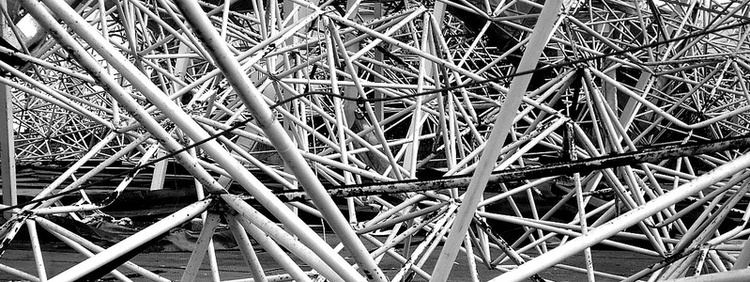 | ||
23 computational complexity
Complexity describes the behaviour of a system or model whose components interact in multiple ways and follow local rules, meaning there is no reasonable higher instruction to define the various possible interactions.
Contents
- 23 computational complexity
- Computational complexity
- Overview
- Disorganized vs organized
- Varied meanings
- Study
- Behaviour
- Mechanisms
- Simulations
- Systems
- Data
- In molecular recognition
- Applications
- References

The stem of the word complexity i.e. Complex is composed of the Latin words com (meaning: "together") and plex (meaning: woven). This is best contrasted with Complicated where plic (meaning: folded) refers to many layers. A complex system is thereby characterised by its inter-dependencies, where as a complicated system is characterised by its layers.

Complexity is generally used to characterize something with many parts where those parts interact with each other in multiple ways, culminating in a higher order of emergence greater than the sum of its parts. Just like there is no absolute definition of "intelligence", there is no absolute definition of "complexity"; the only consensus among researchers is that there is no agreement about the specific definition of complexity. However, a characterization of what is complex is possible. The study of these complex linkages at various scales is the main goal of complex systems theory.

In science, there are as of 2010 a number of approaches to characterizing complexity; this article reflects many of these. Neil Johnson states that "even among scientists, there is no unique definition of complexity – and the scientific notion has traditionally been conveyed using particular examples..." Ultimately he adopts the definition of 'complexity science' as "the study of the phenomena which emerge from a collection of interacting objects."

Computational complexity
Overview

Definitions of complexity often depend on the concept of a confidential "system" – a set of parts or elements that have relationships among them differentiated from relationships with other elements outside the relational regime. Many definitions tend to postulate or assume that complexity expresses a condition of numerous elements in a system and numerous forms of relationships among the elements. However, what one sees as complex and what one sees as simple is relative and changes with time.

Warren Weaver posited in 1948 two forms of complexity: disorganized complexity, and organized complexity. Phenomena of 'disorganized complexity' are treated using probability theory and statistical mechanics, while 'organized complexity' deals with phenomena that escape such approaches and confront "dealing simultaneously with a sizable number of factors which are interrelated into an organic whole". Weaver's 1948 paper has influenced subsequent thinking about complexity.
The approaches that embody concepts of systems, multiple elements, multiple relational regimes, and state spaces might be summarized as implying that complexity arises from the number of distinguishable relational regimes (and their associated state spaces) in a defined system.
Some definitions relate to the algorithmic basis for the expression of a complex phenomenon or model or mathematical expression, as later set out herein.
Disorganized vs. organized
One of the problems in addressing complexity issues has been formalizing the intuitive conceptual distinction between the large number of variances in relationships extant in random collections, and the sometimes large, but smaller, number of relationships between elements in systems where constraints (related to correlation of otherwise independent elements) simultaneously reduce the variations from element independence and create distinguishable regimes of more-uniform, or correlated, relationships, or interactions.
Weaver perceived and addressed this problem, in at least a preliminary way, in drawing a distinction between "disorganized complexity" and "organized complexity".
In Weaver's view, disorganized complexity results from the particular system having a very large number of parts, say millions of parts, or many more. Though the interactions of the parts in a "disorganized complexity" situation can be seen as largely random, the properties of the system as a whole can be understood by using probability and statistical methods.
A prime example of disorganized complexity is a gas in a container, with the gas molecules as the parts. Some would suggest that a system of disorganized complexity may be compared with the (relative) simplicity of planetary orbits – the latter can be predicted by applying Newton's laws of motion. Of course, most real-world systems, including planetary orbits, eventually become theoretically unpredictable even using Newtonian dynamics; as discovered by modern chaos theory.
Organized complexity, in Weaver's view, resides in nothing else than the non-random, or correlated, interaction between the parts. These correlated relationships create a differentiated structure that can, as a system, interact with other systems. The coordinated system manifests properties not carried or dictated by individual parts. The organized aspect of this form of complexity vis-a-vis to other systems than the subject system can be said to "emerge," without any "guiding hand".
The number of parts does not have to be very large for a particular system to have emergent properties. A system of organized complexity may be understood in its properties (behavior among the properties) through modeling and simulation, particularly modeling and simulation with computers. An example of organized complexity is a city neighborhood as a living mechanism, with the neighborhood people among the system's parts.
Varied meanings
In several scientific fields, "complexity" has a precise meaning:
Other fields introduce less precisely defined notions of complexity:
Study
Complexity has always been a part of our environment, and therefore many scientific fields have dealt with complex systems and phenomena. From one perspective, that which is somehow complex – displaying variation without being random – is most worthy of interest given the rewards found in the depths of exploration.
The use of the term complex is often confused with the term complicated. In today's systems, this is the difference between myriad connecting "stovepipes" and effective "integrated" solutions. This means that complex is the opposite of independent, while complicated is the opposite of simple.
While this has led some fields to come up with specific definitions of complexity, there is a more recent movement to regroup observations from different fields to study complexity in itself, whether it appears in anthills, human brains, or stock markets. One such interdisciplinary group of fields is relational order theories.
Behaviour
The behavior of a complex system is often said to be due to emergence and self-organization. Chaos theory has investigated the sensitivity of systems to variations in initial conditions as one cause of complex behaviour.
Mechanisms
Recent developments around artificial life, evolutionary computation and genetic algorithms have led to an increasing emphasis on complexity and complex adaptive systems.
Simulations
In social science, the study on the emergence of macro-properties from the micro-properties, also known as macro-micro view in sociology. The topic is commonly recognized as social complexity that is often related to the use of computer simulation in social science, i.e.: computational sociology.
Systems
Systems theory has long been concerned with the study of complex systems (in recent times, complexity theory and complex systems have also been used as names of the field). These systems are present in the research of a variety disciplines, including biology, economics, and technology. Recently, complexity has become a natural domain of interest of real world socio-cognitive systems and emerging systemics research. Complex systems tend to be high-dimensional, non-linear, and difficult to model. In specific circumstances, they may exhibit low-dimensional behaviour.
Data
In information theory, algorithmic information theory is concerned with the complexity of strings of data.
Complex strings are harder to compress. While intuition tells us that this may depend on the codec used to compress a string (a codec could be theoretically created in any arbitrary language, including one in which the very small command "X" could cause the computer to output a very complicated string like "18995316"), any two Turing-complete languages can be implemented in each other, meaning that the length of two encodings in different languages will vary by at most the length of the "translation" language – which will end up being negligible for sufficiently large data strings.
These algorithmic measures of complexity tend to assign high values to random noise. However, those studying complex systems would not consider randomness as complexity.
Information entropy is also sometimes used in information theory as indicative of complexity.
Recent work in machine learning has examined the complexity of the data as it affects the performance of supervised classification algorithms. Ho and Basu present a set of complexity measures for binary classification problems.
The complexity measures broadly cover:
Instance hardness is a bottom-up approach that first seeks to identify instances that are likely to be misclassified (or, in other words, which instances are the most complex). The characteristics of the instances that are likely to be misclassified are then measured based on the output from a set of hardness measures. The hardness measures are based on several supervised learning techniques such as measuring the number of disagreeing neighbors or the likelihood of the assigned class label given the input features. The information provided by the complexity measures has been examined for use in meta learning to determine for which data sets filtering (or removing suspected noisy instances from the training set) is the most beneficial and could be expanded to other areas.
In molecular recognition
A recent study based on molecular simulations and compliance constants describes molecular recognition as a phenomenon of organisation. Even for small molecules like carbohydrates, the recognition process can not be predicted or designed even assuming that each individual hydrogen bond's strength is exactly known.
Applications
Computational complexity theory is the study of the complexity of problems – that is, the difficulty of solving them. Problems can be classified by complexity class according to the time it takes for an algorithm – usually a computer program – to solve them as a function of the problem size. Some problems are difficult to solve, while others are easy. For example, some difficult problems need algorithms that take an exponential amount of time in terms of the size of the problem to solve. Take the travelling salesman problem, for example. It can be solved in time
Even though a problem may be computationally solvable in principle, in actual practice it may not be that simple. These problems might require large amounts of time or an inordinate amount of space. Computational complexity may be approached from many different aspects. Computational complexity can be investigated on the basis of time, memory or other resources used to solve the problem. Time and space are two of the most important and popular considerations when problems of complexity are analyzed.
There exist a certain class of problems that although they are solvable in principle they require so much time or space that it is not practical to attempt to solve them. These problems are called intractable.
There is another form of complexity called hierarchical complexity. It is orthogonal to the forms of complexity discussed so far, which are called horizontal complexity.
Bejan and Lorente showed that complexity is modest (not maximum, not increasing), and is a feature of the natural phenomenon of design generation in nature, which is predicted by the Constructal law.
Bejan and Lorente also showed that all the optimality (max,min) statements have limited ad-hoc applicability, and are unified under the Constructal law of design and evolution in nature.
